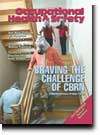
November 2005
Cover Story
By Jerry Laws
Editor's note: NIOSH's National Personal Protective Technology Laboratory continues to develop standards and test procedures for all classes of respirators that protect against chemical, biological, radiological, and nuclear (CBRN) agents.
Features
By Joe Beranek
ACCORDING to the National Fire Protection Association, an average of five fires break out per day at our nation's health care facilities1 and more than 8,000 hospital fires occur each year. If not acted upon quickly and effectively, the results can be catastrophic.
By Bob Henderson
TOXIC VOC exposure is one of the most overlooked hazards in confined space entry. Volatile organic compounds (VOCs) are organic compounds characterized by their tendency to evaporate easily at room temperature.
By Duane Smith
LOCKOUT/TAGOUT procedures specify the steps electricians must follow to remove power from an electrical circuit or panel and to lock out and tag the panel or circuit so no one can re-energize it while work is in progress. An increasing number of specialty contractors, ranging from health inspectors to thermographers, must work around electrical panels and exposed circuits.
For their own safety, these contractors and anyone else who may be exposed to li
By Luanne Freund
THE need to protect employees against air contamination in the workplace has become more critical than ever before.
By William A. Grana, Jr., Stuart G. Clayton
"THE future is here to stay." In terms of safety training, this saying refers to the use and proliferation of Internet-based courseware for delivering training messages, as well as Internet-based software for administering and managing those messages.
By Terri Rebmann, RN, MSN, CIC
THE anthrax incident of 2001 was a small bioterrorism attack in terms of the amount of agent used (the letter addressed to Senator Daschle contained only two to three ounces of anthrax spores, and the other letters contained similar amounts) and the resulting morbidity and mortality. (There were only 22 cases of anthrax and five deaths).
By Fred Elliott
ADEQUATE preparation surely is the answer to many of life's challenges and dangers. It is well established that prevention's value outweighs the cost of incidents themselves (for example, the UK Department for Transport has calculated that the total value of preventing the 229,014 highway accidents in Great Britain in 2001, of which 3,176 were fatal accidents and 31,588 were serious accidents, would have been roughly $31 billion, or about $135,000 per accident).
By Jerry Laws
HOW to prevent eye, face, and head injuries isn't a mystery. But knowing how to protect yourself or your workers does take some analysis, attention, effort, and money. Wearing inadequate protection or none at all is not an alternative if the hazards involved in a given task cannot be eliminated, engineered out, or solved through administrative controls.
By Linda F. Johnson, MS, CSP
FIRE, jolts, arcs, thermal burns, flash burns . . . . There are few workplace scenarios as potentially deadly as those that involve work with electricity or electrical items. Yet we all have a tendency to overlook the most basic of hazards in the workplace, too.
By Ken Liebeskind
ARE you capitalizing on the benefits of the Internet to boost employee training?
Departments
By Jerry Laws
LET'S make it mandatory for building owners and designers to incorporate fall safety during a building's design stage. Please don't tell me this is impractical or too expensive--not when Australia's National Occupational Health and Safety Commission is taking this bold step right now.
By Ray Pelletier, CSP
DOES your workplace suffer from a generational rift? If you're like the majority of companies, the answer is yes. However, today's pressing concern is no longer "how to manage the Generation X crowd." With the Gen X'ers now entering managerial roles, today's biggest concern is how these new young managers can effectively lead people their parents' age.
By Ronnie Rittenberry
Editor's note: All but gone are the days of EH&S consultants' reports being delivered in three-ring binders with accompanying Polaroid prints. Instead, consulting firms such as Kansas City, Mo.-based OCCU-TEC Inc. (www.occutec.com) are delivering data in "living documents" that are easy to maintain, always up to date, and available 24/7 from any computer that has online access.